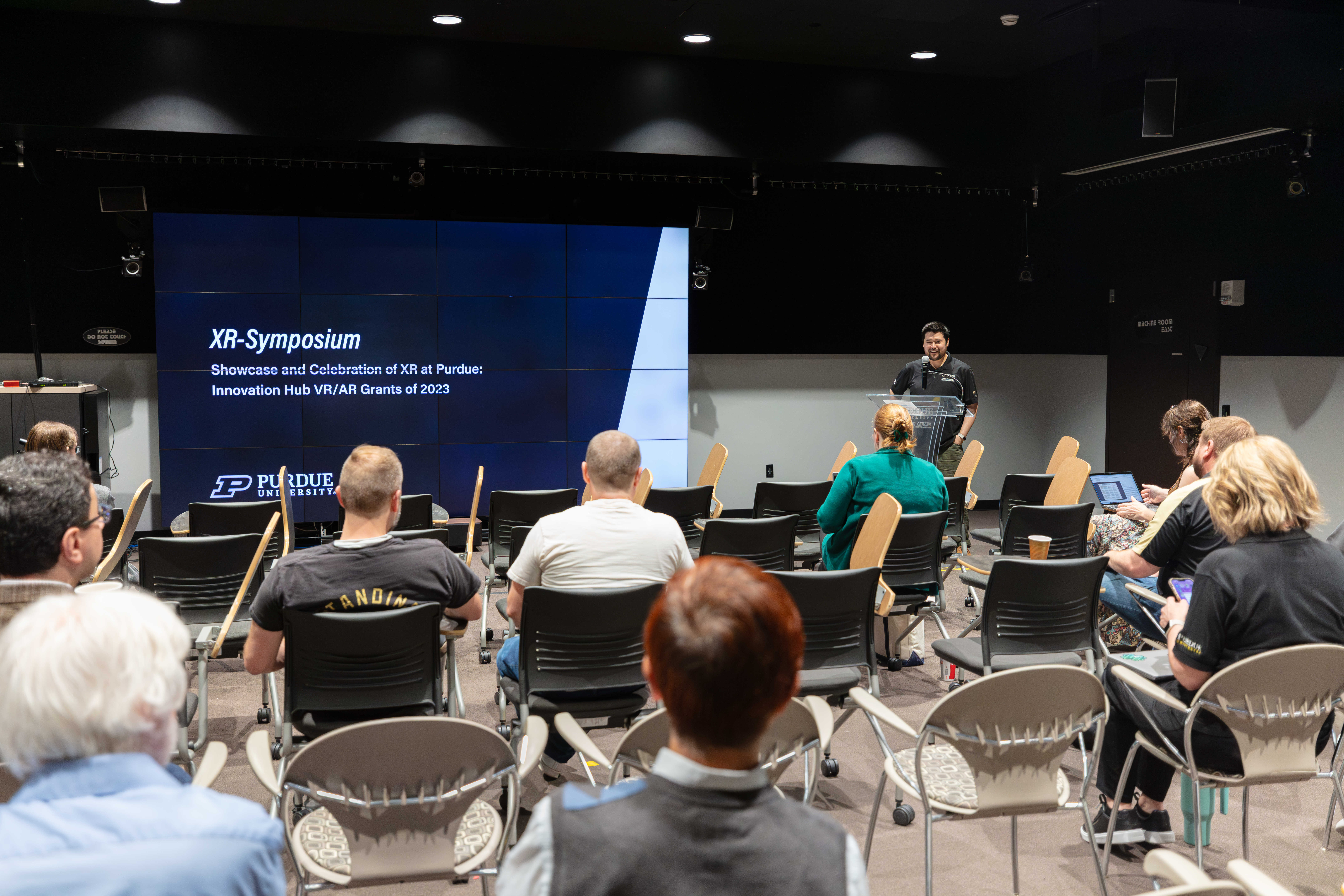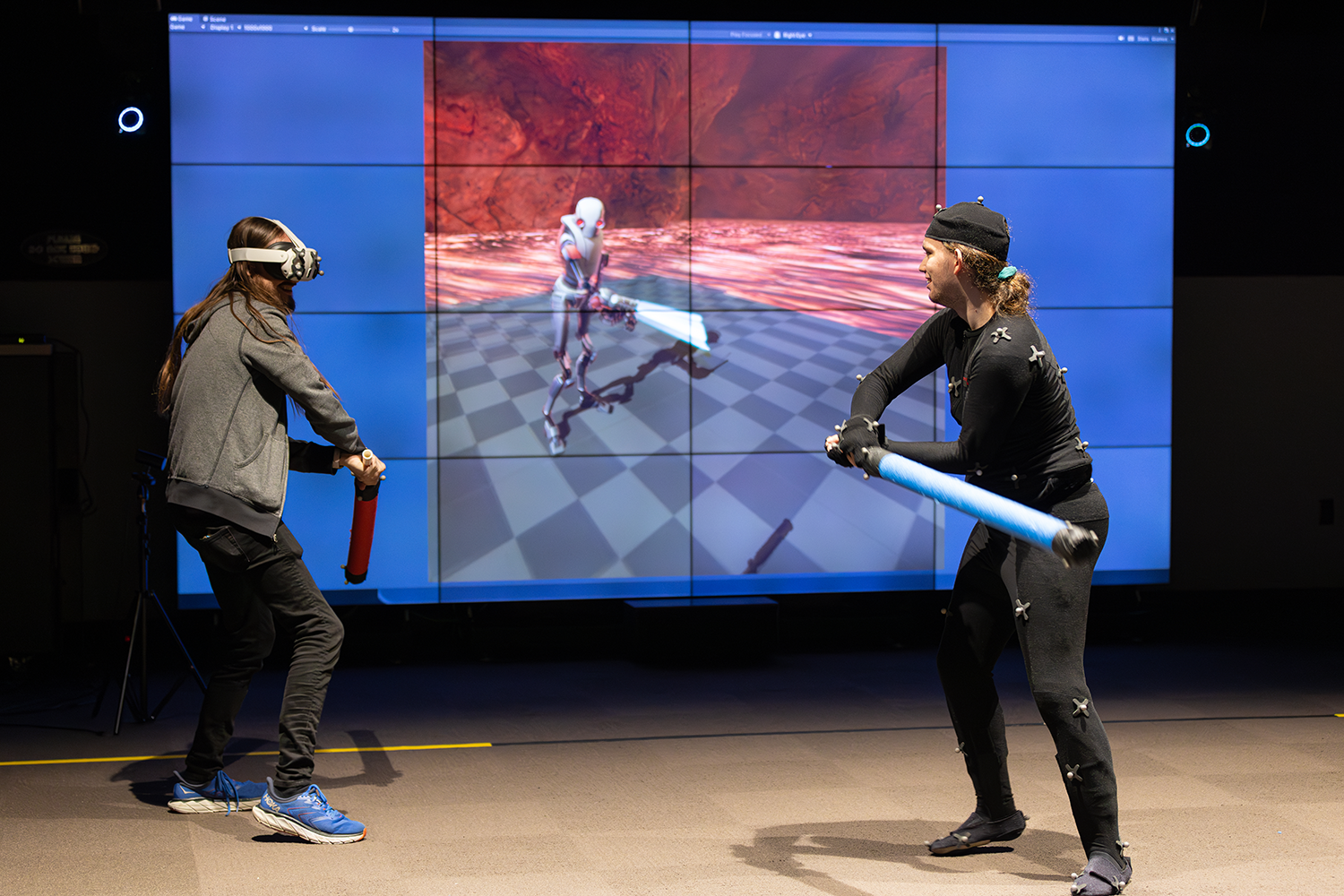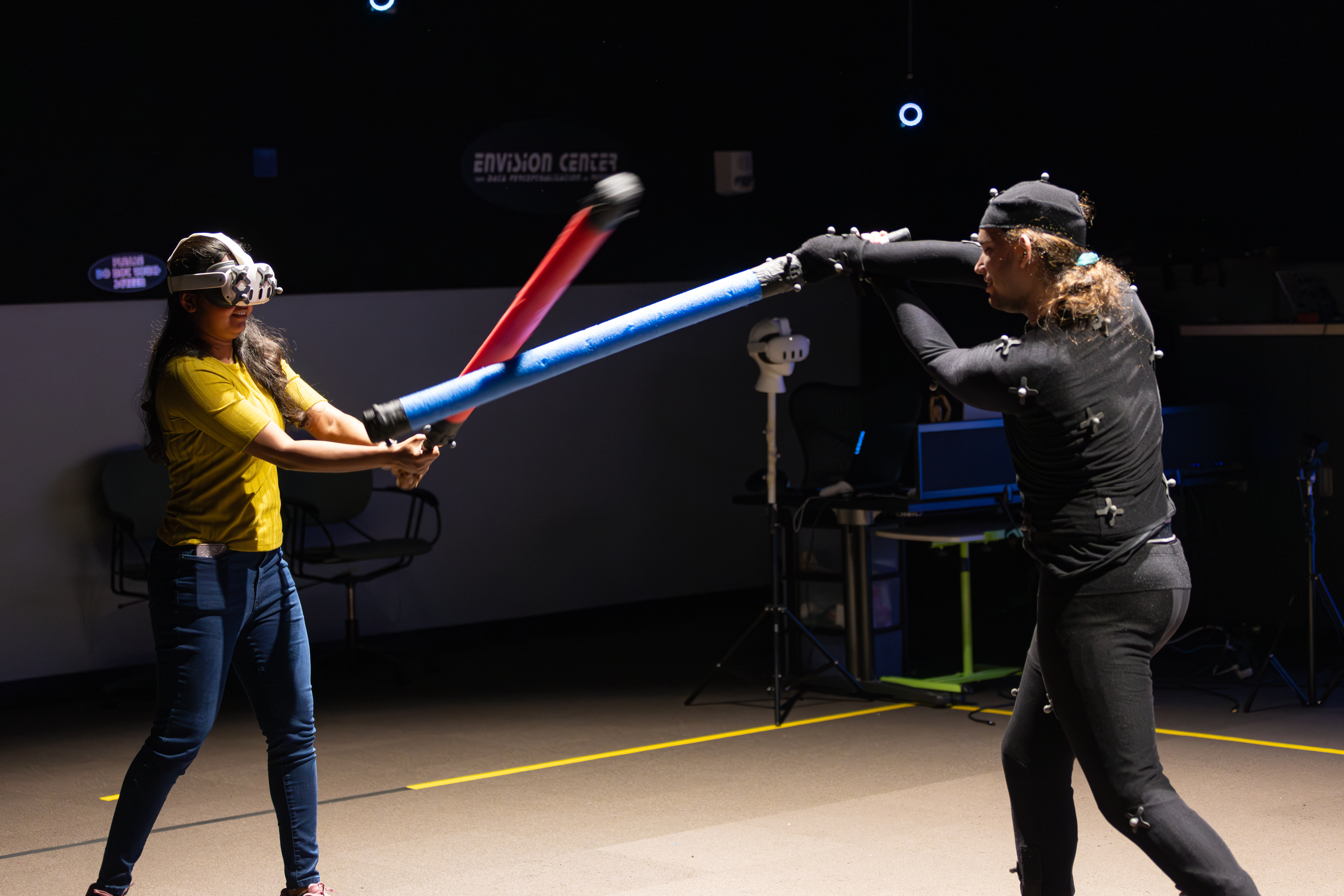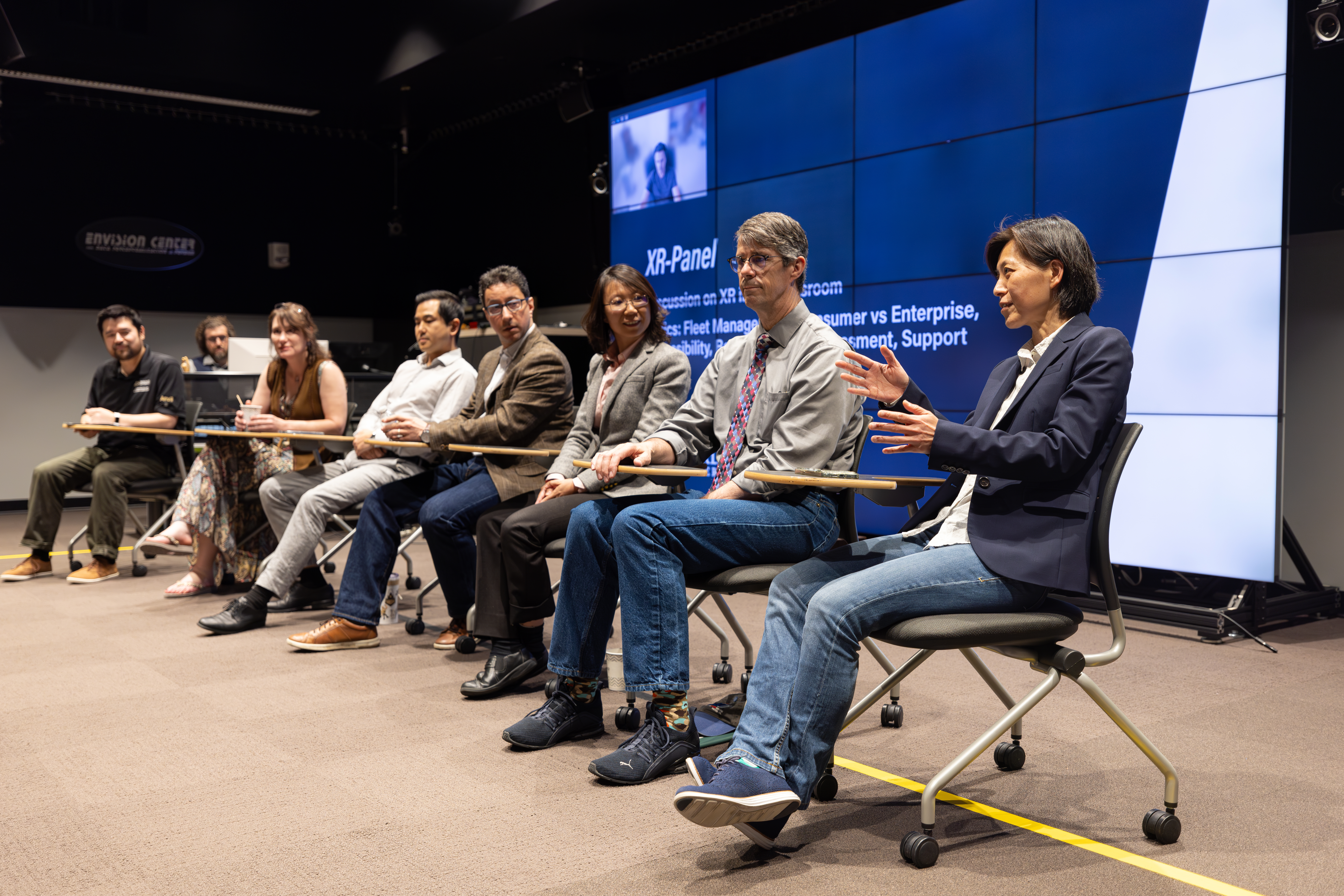20-year birthday celebration for the Envision Center
Purdue’s Rosen Center for Advanced Computing (RCAC) recently celebrated the 20th anniversary of its Envision Center, a group dedicated to assisting, supporting, and collaborating with faculty, students, and industry in scientific visualization, virtual and augmented reality, and media creation.
On April 17th, from morning until evening, the  Envision Center (EC) opened its doors for all to celebrate 20 years of creativity and innovation. The day began with an Open House, running from 10 a.m. until 12 p.m., where EC staff and students helped to showcase many different projects taken on by the center throughout the years. Attendees of the open house were able to experience cutting-edge collaborative virtual experiences firsthand and engage with the development team dedicated to their advancement at Purdue University. One major project put on display was the newly developed Collab XR platform. This platform is a shared environment that allows anyone in a headset to view and interact with the same virtual content pieces together, viewed in fully virtual (the entire field of vision is virtual, obscuring all of the real environment, and other participants appear as virtual avatars) or passthrough augmented reality (cameras feed the real room and people to the headset view, overlaying virtual content to appear to exist in the same space). For the birthday celebration, the Envision Center used the Collab XR platform to showcase a variety of past projects, including a radiation detection simulation, supernova data visualizations, weather system visualizations, insect models, and more.
Envision Center (EC) opened its doors for all to celebrate 20 years of creativity and innovation. The day began with an Open House, running from 10 a.m. until 12 p.m., where EC staff and students helped to showcase many different projects taken on by the center throughout the years. Attendees of the open house were able to experience cutting-edge collaborative virtual experiences firsthand and engage with the development team dedicated to their advancement at Purdue University. One major project put on display was the newly developed Collab XR platform. This platform is a shared environment that allows anyone in a headset to view and interact with the same virtual content pieces together, viewed in fully virtual (the entire field of vision is virtual, obscuring all of the real environment, and other participants appear as virtual avatars) or passthrough augmented reality (cameras feed the real room and people to the headset view, overlaying virtual content to appear to exist in the same space). For the birthday celebration, the Envision Center used the Collab XR platform to showcase a variety of past projects, including a radiation detection simulation, supernova data visualizations, weather system visualizations, insect models, and more.
During the open house, the Envision Center also broke out the MoCap (motion capture) suits to highlight its motion capture systems and abilities. Attendees were invited to engage in a VR “sword fighting” game, wherein they dueled (using foam swords) in virtual reality against an opponent who donned a MoCap suit. The motion capture system tracked the movement of each participant’s sword, as well as the body movements of the opponent, and the first-person perspective from the participant was projected onto a massive screen lovingly known as the Forge Wall. In this way, the cheering bystanders were able to see exactly what the participant was seeing—a platform surrounded by lava, and a realistic moving robot attacking with a lightsaber. While the VR duel is an exciting way to highlight the abilities of motion capture systems, rest assured that it can be—and is—used for serious research. Recent projects that have taken advantage of Envision’s MoCap system include capturing tandem dance movements in order to develop virtual AI dance partners, recording body and instrument movements of a Cellist's performance to use as training data in robotics, and a character animation performance capture to be used in a racial bias study.


Overall, the open house drew quite a crowd. If you weren't able to attend but would like to see an example of the Collab XR platform, please visit the Envision XR Lab webpage: https://www.rcac.purdue.edu/envision/xr-lab. You may also schedule a tour of the Envision Center and experience the center’s work first-hand, here: https://rcac.purdue.edu/about/tour
After a one-hour lunch break, the 20th-anniversary festivities resumed. At this point in the day, the theme shifted from looking at past accomplishments to focusing on current and future XR research and capabilities. From 1 p.m. until 5 p.m., the Envision Center hosted an XR Symposium featuring multiple speakers from across campus, all highlighting the ways in which they are leveraging virtual and augmented reality technologies at Purdue. Each of these speakers discussed how they use XR in research and learning, obstacles they have found in their work, and potential ways to overcome these obstacles.
- 1 p.m.—George Takahashi and Danny Milisavljevic presented “XR Lab, Collaborative XR platform, and Purdue XR Consortium.” The pair discussed the newly developed Collab XR platform and how Milisavljevic uses it to foster interactive learning in his astrophysics classes. Their presentation can be viewed in full here.
- 1:25 p.m.—Voicu Popescu presented “Immersive Visualization in Large Lectures.” During the presentation, Popecu spoke about the fact that large lectures (100+ students in a single classroom) are here to stay, but they do not adequately engage students. He then discussed how he, along with Bedrich Benes, Alejandra Magana, and John Springer, are working to combat this by incorporating XR immersive visualizations. His presentation can be viewed in full here.
- 1:50 p.m.—Victoria Lowell and Stuart White gave their presentation, titled “Emerging Technologies & Learning Design & Tech.” The pair discussed the necessity of integrating emerging technology within learning environments to better prepare students for life after graduation and different ways in which this can be accomplished. Please view their presentation here.
- 2:15 p.m.—Matthew Ward presented “VR Anatomy for Engineering in Medicine.” During his presentation, Ward discussed his Spring 2024 Biomedical Engineering pilot course, which is built upon the use of a VR anatomy lab, and the benefits of having access to in-depth VR cadavers for the medical community. The full presentation can be viewed here.
- 2:45 p.m.—Stylianos Chatzidakis gave a presentation titled “Exploring the VR/AR/MR Options - The Nuclear Pharmacy & Nuclear Engineering Experience.” In this presentation, Chatzidakis discussed the work that he, Kara Weatherman, and Wanju Huang undergo leveraging XR technology for environments where physics plays a significant role, such as mimicking radiation spills and exposure in a nuclear pharmacy or reactor. His presentation can be viewed in full here.
- 3:10 p.m.—Senay Simsek and Ben Paxson presented “IV-STAAR: Integration of Virtual Reality to Support Transformative Active-Learning in Agriculture.” Their presentation highlighted the usefulness of XR technology within the field of Food Science and showcased some of their work, particularly in the realm of Food Chemistry and Food Safety. Please view their presentation here.
- 3:35 p.m.—Tawfiq Salem gave the final presentation of the day, titled “Integrating AI into VR Simulations - Intercultural Teamwork Skills.” Salem discussed the work that he, Kris Acheson-Clair, Mesut Akdere, and George Takahashi have undertaken to train both students and the workforce in smart manufacturing on team/communication skills through the use of XR technology. His presentation can be viewed in full here.
Once the presentations were complete, a panel discussion ensued to close out the festivities. The panel members were Voicu Popescu, Victoria Lowell, Shawn Jung, Wanju Huang, Hua Cai, Stuart White, Stylianos Chatzidakis, and George Takahashi. The panel discussion focused on using XR in the classroom, covering topics such as fleet management, consumer vs. enterprise, accessibility, best practices, assessment, and support. To view the full panel discussion, please visit here.

The Envision Center’s 20-year day of celebrations was a resounding success. The group was able to reminisce on all that has been accomplished throughout the years while also building excitement for all that is to come. The group would also like to make a special note:
“While we are proud of our work, we know that nothing can be accomplished in a void, so we would like to extend a huge thank you to all the researchers and users who have worked with us since our inception. Without you, we can truly say that none of this would be possible. Here’s to the next 20 years!”
If you're interested in attending future XR Consortium meetings, please email us at envision@purdue.edu to be added to the mailing list.
Written by: Jonathan Poole, poole43@purdue.edu
